Azerbaijani art is as ancient and rich as the history of our people. Rock images of Gobustan, artistic ceramic and metal products of caucasian Albania, artistic glass and engraving, examples of Tabriz miniature art, which gained world fame in the middle ages, colorful carpets, embroidery, glazed pottery, tiles, fine carving nets and fine jewelry — all this proves that our artistic heritage is very rich.
Our handicrafts, created thanks to the labor of our people and widely used in his life, have a great and rich history.
Studies have shown that tribes living in the territory of Azerbaijan 4 thousand years ago made original shaped plates of stone, clay, metal, weapons and sometimes samples and used them in their life.
These works of art have long attracted the attention of art researchers with their original form, exact processing and especially its decorations.
Looking at the rich museum collections of Victoria and Albert of London, Louvre of Paris, metropolitan museums of Washington, Vienna, Rome, Berlin, Istanbul, Tehran, Cairo, one can see art works created by skillful hands of Masters of Tabriz, Nakhchivan, Ganja, Gazakh, Guba, Baku, Sheki, Shamakhi and Karabakh.
The spread of these unique works of art to museums and private collections of countries in Europe, Asia and America has a great history. Many of them were taken from separate persons, some were brought by foreign traveler, merchant, diplomat and scientists who visited our country at different times, and some were robbed.
Examples of Azerbaijani art in Moscow museums. Scientific researches carried out for many years showed that today, as in many famous cities of the world, a large part of art samples created by the Azerbaijani people for centuries are protected in Moscow. 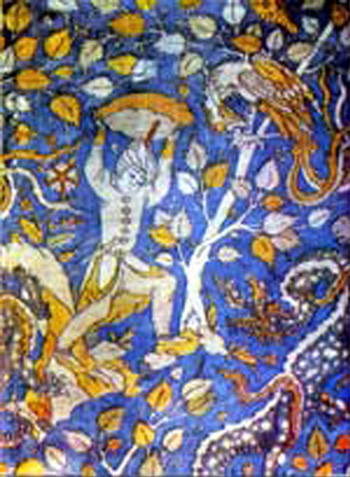
These are mainly in the Kremlin Armory chamber, the Museum of Eastern peoples, the State History Museum, The Museum of folk art, churches in Moscow and its suburbs (Savvo-Storojevsky, Sergiyevo churches, Cyrillic-Belozyersky monastery, etc.).) the sum.
The most artistic and original samples of Azerbaijani craftsmen in Moscow are currently in the arms Chamber of the Kremlin.
Along with samples of Turkish, Iranian, Indian, French, English, German folk art, many original works of art created in Azerbaijan at different times are displayed here.
A large part of the art samples of Azerbaijan in the arms chamber are jewelry and artistic metal products. Of these, the headdresses decorated with precious stones, shields, swords, daggers and ornaments should be especially noted.
An artistic shield of the XVI century among the samples of Azerbaijani jewelry displayed at the Kremlin weapon chamber particularly attracts the attention of the audience.
In connection with the shield, we should mention two interesting works related to this period made in Azerbaijan. One of them is an armored headdress used by nobles during the war, the other is a pair of laces.
There is also no exact information about when and by whom these rare works of art were brought to Moscow as an artistic shield.
Speaking about the decoration of metal items kept in the weapon chamber, sometimes it is necessary to talk about words and words written in Arabic alphabet, which are among paintings and patterns. There are also words that tell which master, for whom, on whose order and when he made it, sometimes words borrowed from the Quran or poems of classical Eastern poets.
Our fabrics stored in the weapon chamber can be divided into two groups according to their artistic characteristics: ornamental and plot fabrics.
Our pieces with a plot are more original and valuable. Because on our pieces of this type we see scenes with different themes, taken from the works of Oriental classics and Azerbaijani folk art.
One of our pieces of this type stored in the weapon chamber is of greater interest.
Examples of Azerbaijani art in the Museums of St. Petersburg. Museums located in St. Petersburg occupy a prominent place among the museums guarding the art samples created by Azerbaijani Masters. Among such museums, the first place is the St. Petersburg State Hermitage, Kazansky Sobor, etc. places can be attributed.

Along with the material culture of Iranian, Turkish, Chinese, Japanese and Arab peoples, many unique art samples created by the Azerbaijani people for centuries are demonstrated in the Department of Oriental Art of the State Hermitage.
There are jewelry, pottery, stone, wood carved works and various types of weaving samples made by Azerbaijani Masters from ancient times to the beginning of our century.
The State Hermitage is primarily a cultural center among the museums of the world protecting the most ancient samples of Azerbaijani art. Here are elegantly shaped pots made of bronze, daggers, axes, belts, etc. jewel things make up an interesting page of our ancient era art.
Bronze bull head figure found during excavations in Daghlig Garabagh with its original form and exact operation among our monuments of the 2nd millennium BC displayed in the Hermitage attracts special attention.
Among the monuments of art belonging to the Bronze Age in the State Hermitage, jewelry art such as belts, bracelets, beads of various shapes and colors are also found.
The 3000-year history of jewelry art found during excavations carried out in Khojaly village of Garabagh in due time attracts attention with its original form and technical execution. It should be noted that some samples of gold jewelry related to the Bronze Age were found here at the State Hermitage.
We also have many examples of metal art dating back to the Middle Ages in the St. Petereburg State Hermitage.
These art samples can be divided into two large groups according to their form and content:
1. Monuments of the nature of plastic art.
2. Household items.
In the list of monuments of plastic art, first of all, the figures of birds, animals and people preserved here from bronze of the V-VIII centuries can be included.
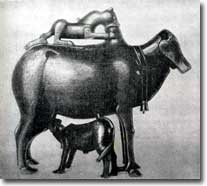
Outstanding St. Petersburg scientist engaged in the history and art of Caucasian Albania academician K.Trever describes these figures as the continuation of this type of pottery found in Mingachevir. One of these figures has attracted the attention of scientists for a long time. This figure belonging to VII century was found in Nakhchivan at the end of XIX century. This figure, which is 35.6 cm high, according to scientists, describes Javanshir (638-670), the ruler of Caucasian Albania.
Two lions and a mountain goat are depicted on the face of the quadrangular base of the figure. On the side there is the stage of the Hunter's fight against lions, elephant, fox and plant ornament motifs.
Shirvan Lule dated to 1206 is considered one of the most interesting exhibits of the Hermitage among our plastic art samples made of metal.
Along with samples of plastic art made of metal, at the St. Petersburg State Hermitage, many original shapes, decorative household items are also displayed. First of all, bronze trays belonging to VI-VIII centuries should be included in the list of such works of art.
In the Hermitage are Three Compasses, dating back to the early Middle Ages. Two of them are decorated with plot images, and the third is purely ornamental.
Bronze boilers of various forms and ornaments dating back to XIII-XIV centuries can be mentioned among household items made of metal.
Our boilers displayed in the Hermitage belong to XIII-XIV centuries and attract attention with their volume, shape and decoration. One of these boilers is particularly interesting.
As it is known, one of the most advanced types of medieval art of Azerbaijan was ceramic art.
There are many wonderful examples of our folk art in the State Hermitage. Our samples of ceramic art stored here are divided into two large groups, both depending on their use and many artistic features.
The first of these are pottery products used in everyday life, the second is tiles used in architecture. Our pottery products used in everyday life represent several exemplary jugs, bowls and surahs found during excavations carried out in oder-Gala (Goranboy region) at the time.
The State Hermitage also exhibits Kashi samples, which are considered decoration of our architectural monuments of the past period. Among them, the main place is occupied by the tiles of Pirhuseyn khanagah on Pirsaatchay in Gazimammad region.
Pirhuseyn khanagah has about 500 different shapes and decorations in the State Hermitage.
Most of our textile art stored in the Hermitage is made up of pile carpets. Our carpets woven in famous Azerbaijani carpet centers from XVI to XIX century are kept here.
Exemplary Azerbaijani carpets woven in Tabriz and Shirvan are considered valuable pearls of the museum. Our carpets woven in Pirabadil villages of Guba, Maraza villages of Shamakhi attract more attention with their color and rich decorative elements. There is an inscription on the Shamakhi carpet stating that it was woven in 1881-1885.
Besides, well-known Azerbaijani artist, ornamentalist painter Mirza Gadim Irevan, who lived in the middle of XIX century in the State Hermitage also has a unique work known to science of art.
The "khamsa"of the Azerbaijani poet Nizami Ganjavi is also protected at the State Hermitage. This unique exhibit is valuable not only as one of the first writings of the five poems of the poet, but also as a wonderful work of art.
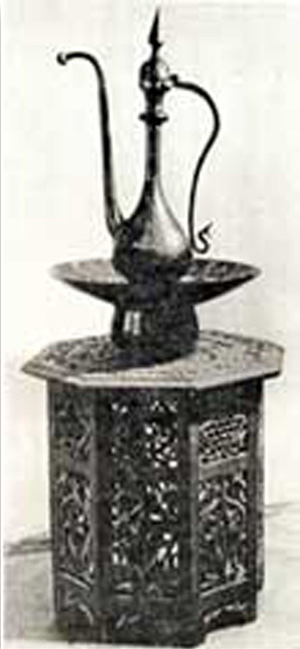
Examples of Azerbaijani art in Budapest museums. Art samples of Azerbaijan in Hungary were kept in private collections till 40s of XX century. Over the past 50-60 years, these unique art samples have gradually been taken under state protection and concentrated in museums. At present, most of the art samples belonging to Azerbaijan are kept in "Decorative Arts" and "Oriental Art" Museum located in Budapest city.
At present, more than 200 samples of folk art of Azerbaijan are preserved in these museums. Among them are carpet, cloth, embroidery, metal and wood, there are many works of art.
As in other foreign museums, most of the art samples of Azerbaijan, concentrated in Budapest museums, are carpets.
Azerbaijani carpets kept here consist of carpets woven at different times in famous art centers such as Baku, Guba, Shamakhi, Shusha, Gazakh and Tabriz.
A small Kazakh carpet woven in the XVIII century, exhibited at the Budapest "Decorative Arts" Museum, attracts attention.
Along with ornamental carpets woven in famous art centers at various times, our carpets with several original compositions are demonstrated at the museums of Budapest.
One of the precious pearls of Budapest museums is the embroidery woven in Azerbaijan at different times. Our sewing here consists of different cover, pillowcase, table, saddle and artistic curtains.
The curtain, decorated by Tabriz masters in the XVI century, which is one of our examples of this type of art, is of particular interest.
Samples of Azerbaijani art stored in Budapest's "Decorative Arts" and "Oriental art" museums do not end with our carpet and embroidery art alone. Monuments of art made of metal, wood and pottery displayed here also attract attention.
Most of the monuments of art made of metal are weapons (sword, dagger) and some household items (collection, sale, lamp). The art samples of XVIII-XIX centuries made from these different types of metals (silver, copper, steel) remind the works of Shirvan Masters for their artistic and technological features. We have only one example of wood art in Budapest museums. He is also artistic creature exhibited at the Museum of" Decorative Arts".
Examples of Azerbaijani art in the United States of America. Handicrafts of Azerbaijani masters are more common especially in the United States of America.

At present, there are rare works of hundreds of Masters in museums, art galleries and private collections in Washington, New York, Chicago, Los Angeles, Philadelphia, Houston, San Francisco, Cleveland, Detroit, Boston and other cities of the USA.
Most of our works of art kept here are samples of carpets, fabrics, artistic metal and pottery.
It is the oldest metal products among our works of art, which are kept in the USA as a historical one.
Our oldest example of metal art is currently in the Metropolitan Area in New York City, USA, and the Asian Art Museum in San Francisco.
Among our works of art metal art kept in the Metopoliten Museum, the most interesting are jewelry items dated to VIII-centuries BC found in ziviya district around Lake Urmia.
Within these works of art, a bracelet made of gold has attracted the attention of many world art critics for its artistic feature and execution.
In the United States, we have especially many examples of metal art dating back to the Middle Ages. These include bronze tableware made in Nakhchivan dating back to XII-XIII centuries, kept in Pierpont Morgan's private collection in New York, bronze tableware with the words "Oljayt Khudabanda" written on Mr. Harari's personal collection, 703 Hijri (1304), and oysters kept in that collection, bronze bowl of XII century with rich ornamental decoration stored in Cleveland Art Museum and other examples.
As in other foreign museums, antique goods stores and private collections, in the USA, Azerbaijani art is most often represented by our carpet art.
At present, we have thousands of samples of pile and pileless, ornamental and excellent types of carpet art woven in the main art centers of our country.
The most ancient Azerbaijani carpets in the United States are displayed in the Metropolitan Museum of New York.
Consider one of our carpets of this type.
The circle-shaped Velvet part kept at the Boston Museum of Fine Arts attracts more attention with its depictions on it.
Examples of Azerbaijani art in Great Britain. One of the places where rare art samples of our people are kept is Great Britain.

There are hundreds of works of art in museums, antique goods stores and private collections in London, Birmingham, Glasgow, Liverpool, Manchester.
The most original works of Azerbaijani Masters in terms of craftsmanship are collected at the Victoria and Albert Museum in London.
Examples of art related to Azerbaijan are displayed in the Middle East section of the museum. These are artistic fabrics, embroidery, carpets, jewelry, pottery and other works of art.
The oldest of our works of art, historically collected at the Victoria and Albert Museum, is the bronze glass dated 1319.
Azerbaijani carpets occupy the most prominent place among our folk art samples kept in Victoria and Albert Museum. They can be divided into two groups according to their artistic and technological features: the first group includes Tabriz carpets of the XVI century, the second group includes Guba-Shirvan, Ganja-Gazakh and Karabakh carpets woven in the XVI-XIX century.
The carpet woven in Karabakh in 1892 is displayed at the London Carpet Museum.
Among the Tabriz carpets displayed at the Victoria and Albert Museum, one should especially mention the carpet woven in Tabriz in 1539 for Ardabil mosque on the order of Shah Tahmasib and famous in the world of science as "Sheikh Safi".
Azerbaijani carpets of the XVII-XIX centuries, stored in the Victoria and Albert Museum, were eventually woven in Guba, Baku, Shamakhi, Gazakh and Karabakh.
As in other museums of the world, the Victoria and Albert Museum has many samples of artistic fabrics of the XVI-XVII centuries. Most of our works of art stored here are narrative works. Among them, three works of art attract special attention.
Examples of Azerbaijani art in France. At present, the largest part of the samples of Azerbaijani crafts kept in France is our samples of weaving art. Hundreds of high-quality fabrics woven in Shamakhi, Sheki, Ganja, Nakhchivan and Tabriz cities of Azerbaijan are kept in many museums and private collections of France. A special place among them is occupied by our fragments of the plot belonging to the XVI-XVII centuries.
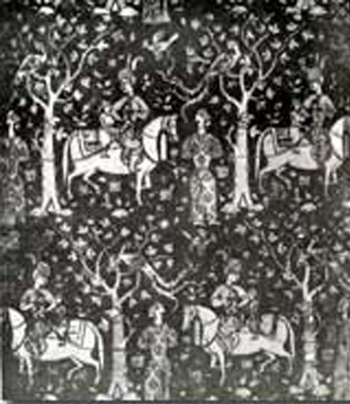
Among our pieces of the plot displayed at the Museum of Decorative Arts in Paris, one of them attracts special attention.
In the Museum of Decorative Arts of Paris we have one piece of original plot of 26 cm in length dating back to the XVI century.
Speaking about examples of French textile art, we should especially mention our carpets displayed in rich museum collections of this country. At present, the most valuable carpets of Azerbaijan both art and technology are in the Paris Museum of Decorative Arts and Louvre.
Let's take a look at one of the carpets kept in the Paris Museum of Decorative Arts.
At present, this cultural center, which is considered one of the world's richest museums, stores hundreds of pottery, tiles and artistic metal samples besides the weaving art we mentioned above.
In the Louvre museum we also have some rare samples of art metal made of silver, copper and bronze. Among them, a bowl with the original figure of 1190, made of bronze, attracts particular attention. This work of art is currently displayed on the first floor of the Louvre Museum, in the middle of the Hall of Oriental Art, on top of a high cut with a glass sleeve.
The originality of this bronze dish, which looks like a bird with a long beak, is not only in its shape, but also in its decoration. The decorations on the bowl consist of three different size belts and medallions placed in the spaces between them.
These ornaments engraved with the technique of forging and scratching were installed from stylized floral ornament elements and writing samples. In one of these writings the name of the master who created it — Osman Salman Oglu Nakhchivan was given.
Examples of Azerbaijani crafts in Switzerland. Examples of art in museums, private collections and antique goods stores in Bern, Geneva, Zurich, Basel, Lausanne can be considered a beautiful page in the history of Azerbaijani art.
Along with European and American material culture, many fine examples of Azerbaijani art are demonstrated in the historical museums of Bern.
The center of the museum's exposition is a large mafrash stylized in combination of blue and red colors and woven with ornament motifs and a rug placed under it. Along with these samples of weaving art on a big label it was mentioned in German that he was woven in Azerbaijan in XVIII century. For its artistic and technological features, reminding the way of execution of Karabakh carpets, this Folk Art sample is considered one of the most beautiful exhibits of the Department of Oriental Art.
One of the interesting carpets kept in the Historical Museum of Bern is "Gollu Chichi" carpet woven in Guba in 1830.
Dagger, sword, pistol and gunpowder containers made in XVIII-XIX centuries in Shamakhi, Goychay, Ganja, Sheki, Baku, Tabriz, Ardabil attract the attention of the audience. In number, the Historical Museum of Bern dominates the works related to the name of Shirvan Masters.
Among the artistic designs of our weapons displayed in the museum, we can see not only floral, geometric patterns, pictures taken from the animal world, but also small plot compositions.
By the way, it is necessary to talk about words and words written in Arabic alphabet, which are sometimes coincided with patterns of different shapes of these weapons. They are skillfully placed between the patterns and drawings of the item by the hand of a skilful craftsman, reminiscent of the beautiful decoration, forming an indissoluble part of the overall composition. In addition to decoration, these articles are also valuable historical sources. For example, on a beautiful silver gunpowder decorated with a tattoo, garasavad method we can see the words "Seyidzade from Shamakhi" (inventory № 832), the places of nappies and barrels attached to the bed - "Amali Ali" (inventory № 766) on a pistol covered with black literacy embroidered silver particles, "Amali Muhammad Ardabili" (inventory № 1178) on a small dagger 38.2 CM and on a dagger with a curve, we read the name of both the master and the owner of the dagger.
The words "Baku", "Guba", "Amali Samad", "Omar" and other names are found on the weapons of Azerbaijan kept in the Historical Museum of Bern.
In addition, there are examples of copper home equipment widely used in the life of our people in XVIII-XIX centuries in the eastern section of the Historical Museum of Bern. Our copper utensils of this original shape are displayed in frames that remind us of the niche on a large stent attached to the wall of the museum.
 Examples of Azerbaijani art in the Federal Republic of Germany. In the Federal Republic of Germany, Azerbaijani handicrafts are represented by one type of carpet art.
Examples of Azerbaijani art in the Federal Republic of Germany. In the Federal Republic of Germany, Azerbaijani handicrafts are represented by one type of carpet art.
This disambiguation page lists articles associated with the title Bonn, Hamburg, Munich, Cologne, Dusseldorf, Frankfurt-Main, Manheim, etc. thousands of samples of carpet art are kept in museums, antique goods stores and private collections located in the cities.
Along with our carpets having ordinary mass character in this country, you can also find sample carpets which are considered very rare in our country woven in hundreds of different centuries.
In terms of originality Kazakh carpet of XVIII century demonstrated in antique goods store in Munich in 1960 also attracts attention.
With its constructive structure, these ornaments, widely spread in the Eastern world, reminiscent of swastika, the ends of which are separated in four different sides, are woven in such a realistic style that they rotate around one point and move. This ornament element is found not only in Kazakh carpets of this type, which received the name "stigmatized", but also in other types of our decorative and Applied Art.
Examples of Azerbaijani crafts in Turkey. Among the Turkish cities, Azerbaijani examples of decorative, applied and fine arts are most concentrated in Istanbul.
The most ancient and beautiful samples of Azerbaijani art can be found in three large museums in Istanbul. These are the Topkapi Palace Museum, The Museum of Turkish and Islamic works and the people's Museum. The most prominent place among our samples of crafts kept in Istanbul museums is various metals (gold, silver, steel, copper, etc.) arranged household items, jewelry samples and weapons.
The gold belt, which is kept in Istanbul's Topkapi Palace Museum, among our samples of crafts made of metal, attracts particular attention.
The steel hood, dated 1528, kept in the Topkapi Palace Museum, is also considered to be one of the valuable monuments giving an idea of medieval Azerbaijani jewelry.
Bronze handicrafts made in Tabriz and Ardabil can be included in our list of metal art samples kept in Istanbul's museums. Bronze alms were religious in the past, clinging to the hills of mosques, madrasa and minarets. Due to the fact that the trunk part of the Alamas was put on the top of the construction, the inside was empty, and the upper one was without ornaments.
The most beautiful part of alms is their upper rescue. It seemed that this part of the hands of a skilful jeweler was given both religious writings and symbolic figurines. At present, our hands are kept in Turkish museums mainly in two forms: horn and pear-shaped. We find on some of them the words of Allah, Muhammad, Ali, depicted in an artistic style, and in others symbolic images.
A number of rare samples of Azerbaijani textile art are kept in Turkish museums. Of these, pieces, artistic embroidery and carpets produced in Shamakhi, Ganja, Sheki, Shusha and Tabriz at the time should be especially noted.
At present, we have several high-level works representing our fabric and embroidery art in Turkish museums, which are mainly concentrated in Istanbul's Topkapi Palace Museum. Within our fabric and embroidery art kept in this outstanding museum, two of them are particularly striking. One of them is a garment of water of the XVI century, and the other is a robe of gold.
Well-known in the world, Azerbaijani carpets are also considered the most beautiful pearls of Turkish museums.
Azerbaijani carpets are concentrated in four large museums in Turkey. These are in the Museum of Turkish and Islamic works in Istanbul, the Topkapi Palace Museum and The Carpet Museum, the Mevlana Museum in Konya.
The oldest Azerbaijani carpet kept in Turkey dates back to XIII century. According to the information given by Turkish art critics, this unique weaving art work of 254 length and 170 cm Width was one of the carpets of Ashraf oghlu jamesinin Nazir was given earlier in Beysahar. In 1932, he was taken to the Mevlana Museum in Konya.
We can also mention the complex painted vase exhibited in the Archaeological Museum in Izmir to the list of our original art samples kept in Turkey.
Samples of Azerbaijani crafts in Iranian museums. Currently, Iran's museums, mosques and private collections hold thousands of unique examples of crafts created by the Azerbaijani people over the centuries. In this regard, the exhibits of the British, Gulistan, archaeological and carpet museums located in the capital Tehran attract special attention.
Artistic metal items found in Hasanli Hill among our art monuments displayed in Tehran's Archaeological Museum attract particular attention.
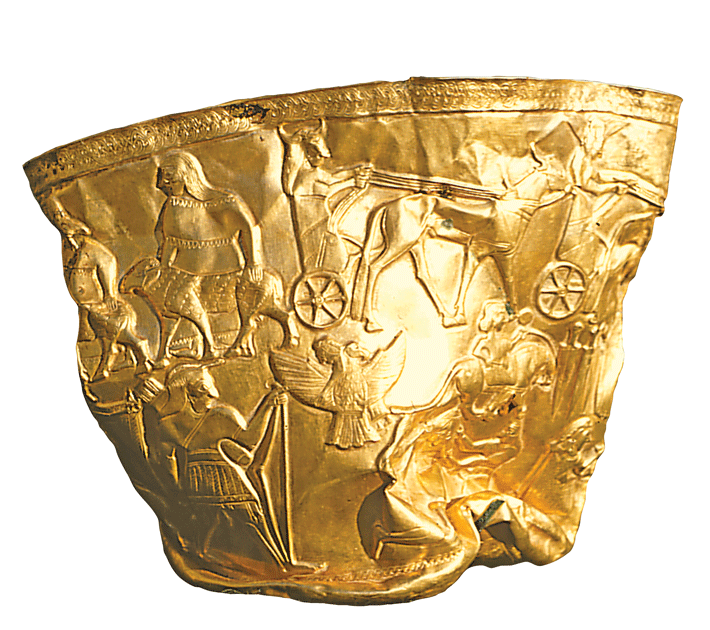
Iran Hasanli Hill is located in the Sulduz District of Azerbaijan. Having beautiful natural conditions, this place was one of the rich cultural centers in the Middle East a thousand years ago. Sources show that the manna tribe, which was part of the Great median state, once lived in this area. In 1956-1957, among the monuments of art found in Hasanli Hill, the golden glass, which is currently displayed in Tehran's Archaeological Museum, attracted the attention of scientists from around the world.
There are also many scenes in the following row that attract attention. It depicts a hunter with a snake on his head, a naked woman standing on two Rams next to him, a man stretching his hands to the pahlav standing on the side to escape from the claw of a three-headed dragon. These scenes are located in the middle of the glass. In the relatively low parts of the glass is depicted an old man sitting in small sandals. A woman stands in front of him, stretching her little child to him. A man with his face towards the sandalwood stood on top of this scene holding an unknown pot in his hand. There are three other drawings in the picture above, the description of a hunter with a snake on his head.
The interaction of Azerbaijani culture with neighboring states during these periods is clearly evidenced by the golden chest found in the area of Lake Urmia, dating back to the VIII-VII centuries BC.
Carpets woven in Azerbaijan are also kept in Iranian museums. The carpet woven in Pirabadil village of Guba can be mentioned among them.
In the 90s of the XX century, as a result of the aggressive policy of Armenia, our cultural heritage was severely damaged, our national cultural monuments were brutally destroyed. Valuable items related to the history and culture of the Azerbaijani people, works of painting and culture, world-famous carpets, memorial items of prominent personalities of Azerbaijan and other valuable materials were plundered in our museums looted by Armenians.
Now, thanks to the care of our state, art samples of Azerbaijan are preserved and introduced in the world under the care of its owner and stand in the most honorable place. Since 2008, Azerbaijan's material and cultural values have taken their place in the UNESCO Intangible Cultural Heritage list. This is a reliable guarantee to prevent the theft and embezzlement of our cultural monuments in the future. In this sense, the role and hard work of the Heydar Aliyev Foundation and its president Mehriban Aliyeva are undeniable.



